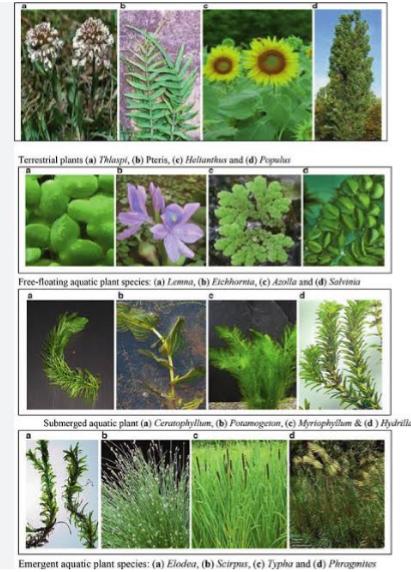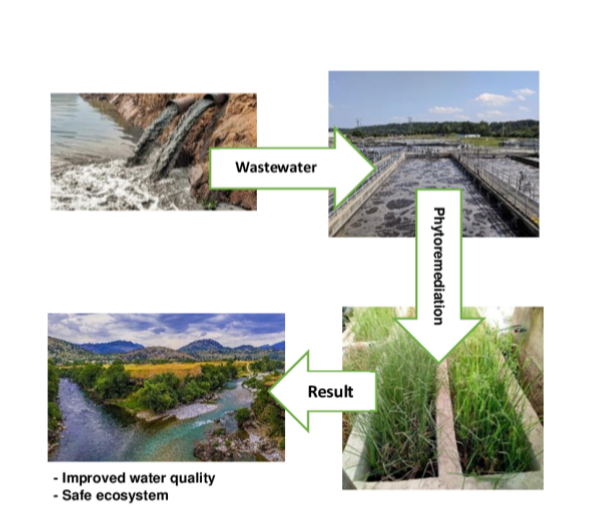
Pollution is the contamination of the environment, making it foul or filthy by destroying its purity. Or it can be simply defined as the introduction of harmful materials into the environment. These harmful materials are call pollutants. Pollutants can be natural, such as volcanic ash or created through human activities, such as trash or wastes produced by industries.
Pollution affects all living things either by damage to tissues or by causing illness or diseases and often lead to adverse effects on ecosystems. It damages the quality of air, water, and land. Man and other organisms totally depend on clean water, pure air and fertile soil for survival. Pollution can occur in the atmosphere, in soil and in water bodies (sea and freshwater). It may be caused by the following ways;
1. By chemical pesticides and weed killers
2. During production of materials in industrial processes with wastes released into atmosphere, streams, rivers or soil
3. By production of radioactive materials including thermal pollution( overheating of water)
4. By accumulation of waste materials.
CONTAMINANTS
1. Heavy metals : (Cd, Ni, As, Cr, Co, Ni, Se, Zn, V, Hg, Pb).
2. Petroleum hydrocarbon
3. Surfactants
4. Nutrients like nitrates, ammonium and phosphate
5. Pesticides and other agrochemicals
6. Explosives
7. Radionuclides ( Cs, Sr, Ur)
8. Polynuclear aromatic hydrocarbon
9. Polychlorinated biphenyls
10. Chlorinated solvents
TYPES OF POLLUTION
1. AIR POLLUTION: Air pollution is caused by pollutants such as dust, soot, smoke, lead dust from petrol fumes, coal dust, sulphur dioxide, carbon monoxide, traces of acids and pollen and spores of bacteria and fungi, burning of organic substances like coal, gas and oil. Natural disasters can also cause air pollution for example, volcanic eruption can eject volcanic ash and gases (sulfur dioxide) into the atmosphere which can discolour the sky for months. Thus, affecting crop yield and make the soil infertile for years.
Air pollution can make people’s eyes burn, difficulty in breathing and also increase the risk of lung cancer. It can also kill quickly. When air pollutants such as nitrogen oxide and sulfur dioxide mix with moisture, they change into acids. Acid rain can kill all the trees in a forest. It can also devastate lakes, streams, and other waterways causing dead lakes. When lakes become acidic, fish cannot survive.
2. SOIL AND WATER POLLUTION: Pollution in the air eventually reaches soil and water and soil pollutants can be washed into nearby water body. Soil and water pollutants include agrochemicals like pesticides, Fertilizers and hydrocarbon. Water pollutants include industrial discharge such as oil film, oil spills, sulphide and sulphite, detergents, nitrates, sewage, and refuse etc
TOLERANT PLANTS AND CONTAMINANTS
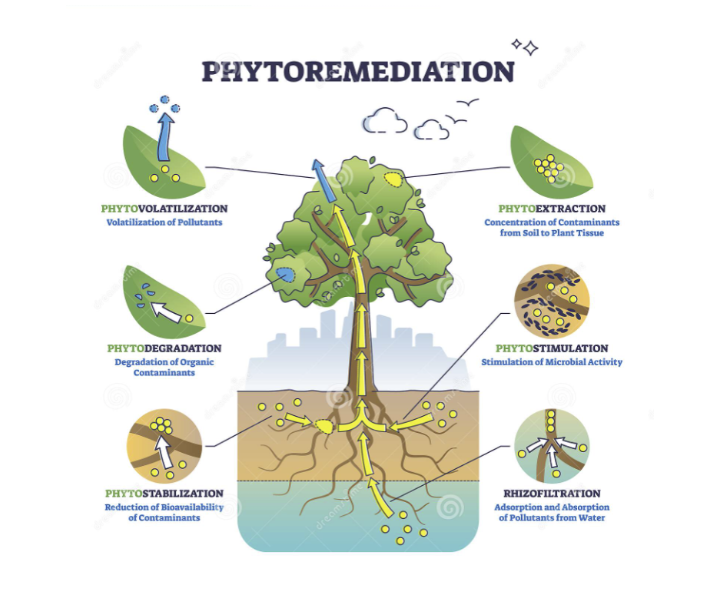
a. DESCRIPTION OF HOW PLANTS UPTAKE NUTRIENTS : Green plants manufacture their food through the process called photosynthesis. They use the pigment called chlorophyll to carry out the process. Not all plants have chlorophyll, some plants have other pigments apart from chlorophyll to manufacture their own food. Apart from photosynthesis, plants also absorb nutrients from the soil using their root system. When the nutrients are being absorbed by the root hairs, they are translocated through the vascular system (xylem tissue) to other parts of the shoot system. Note, xylem transport water and solutes containing dissolved nutrients from the soil through the root, to parts of the plant. While phloem tissue transport photosyntates manufactured during the process of photosynthesis from green parts of the plant to other parts of the plant.
Plant nutrients are macro nutrients and micronutrients. These nutrient elements can either be heavy metal or not, causing pollution to the environment.
b. HEAVY METALS: Heavy metals are those elements which have specific weight of more than 5 g cm3 . The metals that are at least 5 times denser than water are also referred to as Heavy Metals. Heavy metals are either essential (Mo, Mn Cu, Ni, Fe, Zn) or non-essential metals (Cd, Ni, As, Hg, Pb). This means that some essential micronutrients ( that is, they are required in small quantities for the normal growth of plants and/or animals) when in excess are termed heavy metals. For example, Copper (Cu), manganese (Mn), molybdenum (Mo), nickel (Ni) and zinc (Zn) can become heavy metals eventhough they are essential for higher plants. For animals and humans, chromium (Cr), copper (Cu) , cobalt (Co), Mn, Mo, selenium (Se), vanadium (V) and zinc ( Zn) are the micronutrient heavy metal(loid)s. Iron (Fe), not usually considered a heavy metal is essential for both plants and animals. Several other elements, including arsenic (As), cadmium (Cd), lead (Pb) and tin (Sn) may possibly have an essential role at very low concentrations. But at high concentration, they are heavy metals.
These heavy metals pollutants can restrict the growth of plants, affecting the plant system, seed germination, production, physiological, biochemical, and genetic elements.
Most heavy metals occur naturally, but a few are derived from anthropogenic sources. The most common ones which can pollute the environment are Arsenic, cadmium, chromium, copper, nickel, lead and mercury. They are essential to life but can become toxic through accumulation in organisms. Mercury, lead and cadmium are of greatest concern because of their ability to travel long distances in the atmosphere. Other characteristics of Heavy metals are; they have high atomic mass and toxicity to living organisms. Most heavy metals cause environmental and atmospheric pollution, and may be lethal to humans. Heavy metals can become strongly toxic by mixing with different environmental elements, such as water, soil, and air, and humans and other living organisms can be exposed to them through the food they consume.
Sources of heavy metals include mining, industrial production (foundries, smelters, oil refineries, petrochemical plants, pesticide production, chemical industry), untreated sewage sludge and diffuse sources such as metal piping, traffic and combustion by-products from coal-burning power stations
c. OIL SPILL: This is the spread of oil in the oceans due to pipes leakage. When this occur, the marine ecosystem becomes polluted. This pollution can also spreads to nearby lands. Thus, causing land pollution. Other reasons that causes oil spills include; during transfer of oil from containers to other containers, breaking pipelines through which oil is transported from one place to another and at the time of drilling in the earth’s crust. Also leakages or discharge can be from a ship, lorry, truck etc or an accidental release of oil into a body of water from tankers, or underwater pipeline leakages. Oil is a mixture of hydrocarbons which causes harm to the surrounding environment, destroying animals and plants. Crude oil which is composed of gas, kerosene and light gas can cause hazardous effects on the ecosystems. Oil spill in water bodies can cause the death of aquatic organisms and can cause a great health problem on the people who consume the seafood harvested from such contaminated water bodies. When oil spills occur in the ocean, the oil spread on the surface and does not mix with the water forming a thick layer on the water surface called slick expands. This prevent sunlight from penetrating the water to reach the aquatic animals and plants. Also, birds and sea mammals around the coastline will be covered with oil. Oil spill have a great impact on economy of the nation.
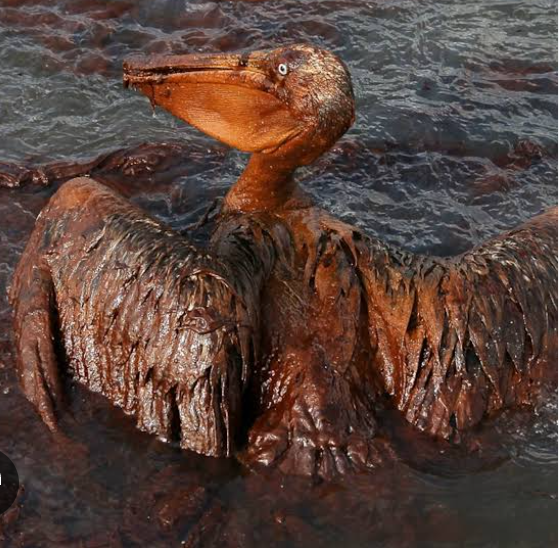
To clean up these organic chemicals and metal pollution from the contaminated sites and degrade them, tolerant plants called hyperaccumulators can be used. These plants are responsible for storing large amount of metals, including metals not required for plant functioning, mopping up oil spills and other contaminants from contaminated sites. Examples of such plants include; alfalfa (Medicago sativa ) and ryegrass (Lolium perenne ), Oryza sativa (rice), Pistia stratiotes (water lettuce), Pisum sativum (pea), Brassica juncea (mustard) , alpine penny cress, pennywort ( Hydrcotyle umbellata), water velvet ( Azolla pinnata), hemp, duckweed ( Lemna minor), Sunflower ( Helianthus annuus) and pig weed etc have demonstrated their ability to hyperaccumulate toxins at toxic waste sites.

PHYTOREMEDIATION,
Phytoremediation is a bioremediation process which involve the use of various types of plants to remove, clean, and/or destroy contaminants in the soil and groundwater.
It is a new advanced bioremediation technique involving plants and their parts for the remediation and recovery of contaminated soil and groundwater.
Phytoremediation methods potentially degrade, accumulate, immobilize, and transform contaminants by acting as a biofilter and metabolizing the pollutant. It is a cost-effective and innovative alternative method to conventional techniques.
WORKING MECHANISMS OF PHYTOREMEDIATION
Plants possess an uptake mechanism for the uptake of nutrients and also for clearance of contaminated material from the site. Not all plants can be used for phytoremediation. Only tolerant plants are cultivated to uptake contaminants from the soil and accumulate them in their aboveground shoot which are periodically harvested, thereby removing the contaminant from the soil. Roots uptake the pollutants along with water and minerals and translocate them to the shoots and leaves through the xylem and phloem tissues. These plants and their parts which mop up the contaminants are then harvested and distroyed. This brings about a continuous cleaning of the site. Trace metals accumulated in plant biomass can be burned to produce metal-enriched ash or to obtain a bio-ore of economic value (the process is known as phytomining).
Phytoremediation is only applicable if the soil contamination does not exceed 3 feet from the surface and 10 feet from groundwater surface
TYPES OF PHYTOREMEDIATION :
Phytoremediation is classified on the basis of the pollutant type, such as elemental, organic compound, accumulation, degradation, stabilization, volatilization, transformation, filtration, and a combination of these processes. All phytoremediation methods are assisted by one microbs or the other.
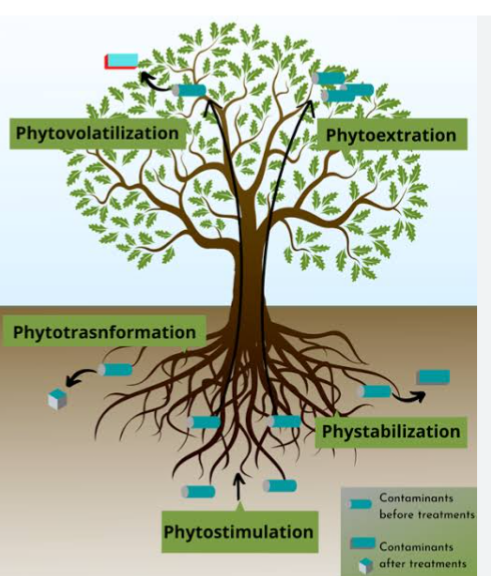
1. PHYTOEXTRACTION OR PHYTOACCUMULATION : In this method, Plants extract or uptake pollutants from the soil or groundwater through their roots and accumulate the pollutants in their roots, shoots, and leaves which are harvestable tissues. After the complete accumulation of pollutants, the parts are harvested and disposed off or recycled. This method is used to treat metal-contaminated sites. It is commonly applied to water-soluble metals like Lead (Pb). This method is also known as Phytoaccumulation or Rhizoaccumulation. Microbes involved are Rhizophora spp, Rumex crispus, and Sedum alfredii.
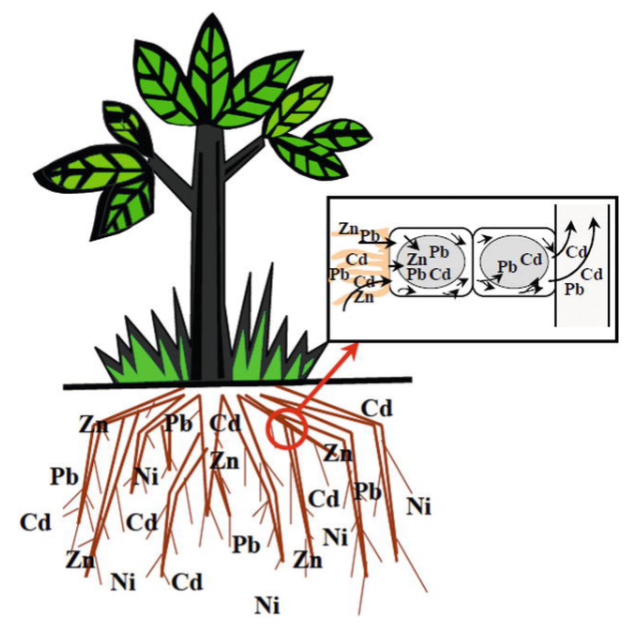
2. PHYTODEGRADATION : In this method, plants uptake and break down pollutants within their tissues using internal enzymatic activity. The plants degrades the contaminants by releasing enzymes from their roots, or by metabolic activity inside plant tissues into the soil or groundwater to degrade the organic pollutant. The Plants uptake the organic pollutants by their roots and converted into less toxic and less hazardous forms thus, incorporate the harmless substances into plant tissues to promote plant growth.
This degradation is based on the symbiotic relationship between plants and microbes. The microbes involved are Pueraria, and Elodea canadensis.
3. PHYTOSTABILIZATION : It is also called plant assisted bioremediation. Phytostabilization can be enhanced using different methods, one of which is by the use of soil amendments which are exudates or enzymes produced by stimulating microbs, fungi or by plants to the root zones or rhizosphere to immobilize metals or metalloids in the soil or ground water. The soil ammendments is used to acclimatize the plant species to tolerate the high levels of metals. Microbes involved are Anthyllis vulneraria, and Festuca arvernensis.
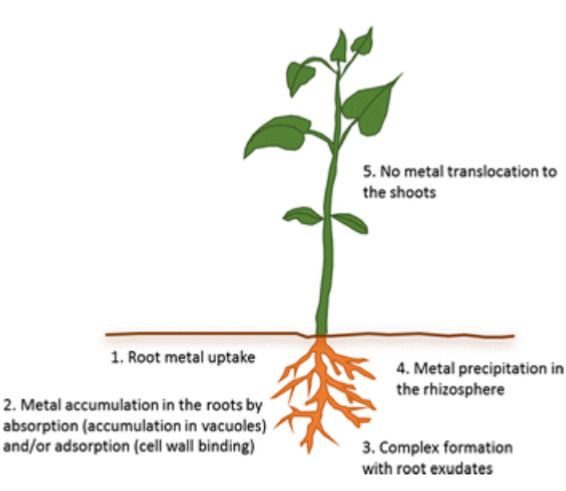
4. PHYTOTRANSFORMATION : Conversion of toxic and harmful pollutants into nontoxic and harmless forms and incorporate them into plants tissues. Microbes involved are Cannas.
5. RHIZOFILTERATION : This is involves the filtering of contaminated groundwater by plants. Similar to Phytoextraction, but differ in that the plants employed are cultivated in greenhouses with their roots in water rather than soil. Plants uptake contaminants along with the water and accumulate it into shoots and leaves by xylem and phloem. The plant accumulates the contaminants until its roots reach saturation. After attaining saturation, the plant roots are disposed off safely and the site is treated properly. Microbes involved are Brassica juncea, Aruna donax, Eichornia crassipes, Plectranthus amboinicus, and Carex penduta.

6. PHYTOVOLATILIZATION : In this process, Plants accumulate volatile organic contaminants by their roots and translocate them into their shoots system. The translocated contaminants get converted into volatile gases which vaporize into the atmosphere from the leaves. The microbes involved are Liriodendron tulipifera
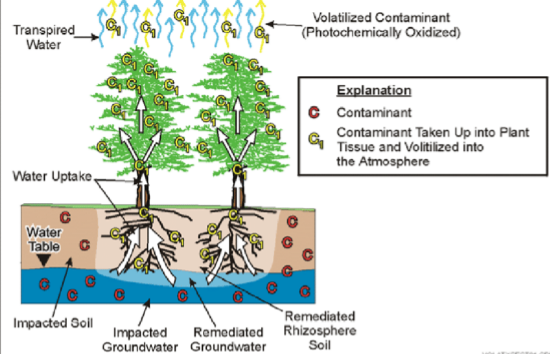
ADVANTAGES OF PHYTOREMEDIATION :
1. COST EFFECTIVE : Phytoremediation is cost-effective as it does not require any huge equipment to carry out the cleaning. Plant species can be sourced from the wild.
2. AESTHETIC AND MULTIPURPOSE PROPERTIES OF PLANTS: Plants like trees and sunflower used at remediation sites makes the sites aesthetic. The plants can serve as windbreaks and erosion control
3. EASE OF PLANT CULTIVATION: Plants can be easily grown without much effort. Seeds and seedlings of tolerant plants are easy to plant and they protects the ecosystem in a more natural way,
4. IMPROVE SOIL HEALTH: Phytoremediation improves soil’s fertility, soil health, and crop yield. Biomas cover protect the soil from erosion. Toxicity of micronutrients are reduced.
5. REDUCE THE RISK OF CONTAMINANT SPREAD: No excavation and transportion of contaminated mass is carried out. Hence, reduce the risk of spreading contamination to unaffected sites etc
DISADVANTAGES OF PHYTOREMEDIATION :
1. TOLERANCE OF PLANT SPECIES : Not all plants are tolerant to contamination. Only the tolerant plants species can be used to achieve a successful remediation.
2. REQUIRES SKILL: It may require the extraction of soil amendment to be released at the rhizosphere. Therefore, technical knowledge of exudate and enzyme extraction may be needed
3.HARMFUL EFFECT OF MOPPED CONTAMINANTS: When contaminants are mopped up by plants and stored in the woody tissues, when such plants are used as fuel, the fumes from the burning are harmful.
4. METALS BONDING TO SOIL COLLOIDS AND ORGANIC MATTER : Heavy metals can become bonded to the organic matter and clay colloids in the soil, making it impossible for the plant to remove.
5. TIME CONSUMING METHOD: Phytoremediation is much slower than other remediation methods. It takes time for the plant to development extensive root and shoot system especially when trees are used. Also, total clearing of contaminants may require occational harvesting and planting. This is time consuming.
